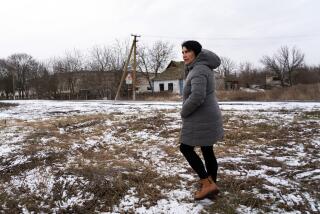BOOK REVIEW : A Journey Through Siberia : SIBERIAN ODYSSEY; A Voyage Into the Russian Soul, <i> by Frederick Kempe</i> , Putnam’s $22.95, 304 pages
- Share via
One day in 1979, the sandy banks of the Ob River in Siberia began to crumble, and an “avalanche of bodies” poured into the water--the buried victims of some long-forgotten mass execution of the Stalin era.
“The Ob River had unearthed not only a grave but also the lies upon which an entire system had been built,” observes Frederick Kempe, who recounts the emblematic story in “Siberian Odyssey.” “The collapse of its banks was perhaps a too-obvious metaphor for the crumbling of a state structure that could be held up only by the sort of repression that had created the grave in the first place.”
Kempe was among a small party of Western journalists and scientists who trekked across Siberia--”Russia’s Heart of Darkness,” as Kempe puts it--shortly after the collapse of the Soviet Union in 1991.
Their journey is described in “Siberian Odyssey,” a blend of armchair adventure, political reportage, and travelogue.
The subtitle of Kempe’s book--”A Voyage Into the Russian Soul”--is a bit too self-congratulatory, but it’s perfectly true that “Siberian Odyssey” allows us to glimpse some of the darker and genuinely surprising recesses of the Iron Curtain.
What we see is a place of vast natural resources and natural beauty that has been literally brutalized by poverty, pollution, and bloodthirsty political oppression.
Kempe’s itinerary included oil fields and bomb factories, prisons and steel mills, jazz clubs and drunk tanks (including one charmingly dubbed “Medical Sobering-Up Place 5”), aboriginal villages and KGB prisons, a community of Volga Germans who were banished to Siberia by Stalin during World War II, a town where Stalin himself was exiled by the Czarist secret police, even the site of a failed American colony founded by Big Bill Haywood, the American labor leader.
The Siberians whom Kempe encounters--the so-called “White Birds”--include the survivors of the worst excesses of the Gulag, the pioneers who built roads and factories in the frozen tundra, the remnants of the native peoples who outlasted Ivan the Terrible and Lenin and Gorbachev, too.
These men and women have opened themselves up to Kempe with touching candor, and the best moments in his book are the confessions that he extracts from otherwise ordinary people.
To the Russians, including the people of Siberia, the West is a beacon of light and hope. Gucci T-shirts abound, and “Dallas” is still a hit show. Business cards with Roman and Japanese lettering are de rigueur among upwardly mobile factory managers.
And Kempe himself--a reporter for the Wall Street Journal--is regarded as a broker for the “joint ventures” and “partnerships” that have taken the place of Marxist iconography in Russia’s conception of its own destiny.
Still, Kempe managed to find a lingering regard for Stalin, especially among men and women who feel threatened by the sheer absence of authority: “I still believe that if we had Stalin now, everything would be OK,” one woman told him, “I’m not a Stalinist, but if the leadership of the country would impose a little more order, we would be better off.” According to Kempe, Siberia is, above all, an immense ecological disaster waiting to happen.
When Kempe discovers that asbestos hung in cloth sacks from the rafters of a coal mine is used as a primitive form of fire-control, he asks about the health risk--and his guide is surprised to learn that asbestos is a carcinogen. “Thank you for this information,” he says politely. And, as Kempe points out, alcohol is a component of virtually every problem that afflicts Siberians--from crime in the streets to economic malaise in the factories.
A police lieutenant even dismisses the blight of pollution with a vodka toast: “This is the best detergent for whatever contamination we have.”
Kempe has a disconcerting tendency to fill out and fatten up his book with statistical asides and rhetorical tap-dances: “So this was the nuclear soul of the Communist beast that had so threatened the free world,” he writes of Tomsk 7, an installation where weapons-grade plutonium is manufactured. “I was passing the epicenter of the Evil Empire, the radioactive core of the Red Threat.”
And yet, after all these flourishes, there’s no payoff: “In my memory, however, it remains only a gray blur.”
Kempe presents the Siberian people as courageous, colorful, long-suffering and capable of heroic sacrifice. But one is left with the impression that Siberia is mired in despair, moral and physical fatigue, and an ennui so deep that it cannot be penetrated even by the seductions of “Dallas” and the American Dream: “Maybe you want to take me to America,” says one old woman, only half in jest. “But I am too old to go to America. The cemetery will be my America.”
More to Read
Sign up for our Book Club newsletter
Get the latest news, events and more from the Los Angeles Times Book Club, and help us get L.A. reading and talking.
You may occasionally receive promotional content from the Los Angeles Times.







